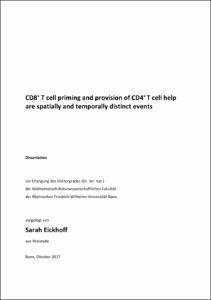CD8+ T cell priming and provision of CD4+ T cell help are spatially and temporally distinct events

CD8+ T cell priming and provision of CD4+ T cell help are spatially and temporally distinct events

| dc.contributor.advisor | Kastenmüller, Wolfgang | |
| dc.contributor.author | Eickhoff, Sarah | |
| dc.date.accessioned | 2020-04-25T09:26:42Z | |
| dc.date.available | 2020-04-25T09:26:42Z | |
| dc.date.issued | 03.07.2018 | |
| dc.identifier.uri | https://hdl.handle.net/20.500.11811/7593 | |
| dc.description.abstract | The generation of a protective memory CD8+ T cell response requires priming of naïve T cells by dendritic cells and consecutive proliferation and differentiation of CD8+ T cells. In this differentiation process CD8+ T cells integrate multiple signals, including TCR-mediated stimulation, co-stimulation as well as cytokine-mediated activation. Co-stimulation and cytokine-mediated activation are in part dependent on CD4+ T cell helper signals. However, CD4+ T cell help for CD8+ T cells is not directly transmitted but rather provided by an intermediate cell population - dendritic cells. In this study, I investigated which DC subset serves as the critical communication platform between CD4+ T helper and CD8+ T cells in order to optimize CD8+ T cell priming. Additionally, I aimed to address the spatio-temporal dynamics of such interactions in vivo, asking when and where those interactions may take place during an antiviral immune response. Interestingly, I found that CD4+ and CD8+ T cells were initially primed on spatial separated DC. CD8+ T cells were activated on directly infected DC in the periphery of the LN whereas CD4+ T cells were activated on non-infected DC in the LN paracortex. Notably, only during the later phase of infection (> 24h), both CD4+ and CD8+ T cells interacted with antigen-presenting non-infected XCR1+ DC within the paracortex of the LN. This critical activation step happened after the initial DC encounter of both lymphocyte subsets, but before they started to proliferate. On a functional level, I found that anti-viral CD8+ T cell responses activated in the absence of XCR1+ DC failed to differentiate into fully functional memory CD8+ T cells, mimicking the lack of CD4+ T cell help. In conclusion, this study identifies a new phase of T cell programing that reveals multiple DC interactions during the initial lymphocyte priming step, is critical for the development of a functional memory CD8+ T cell compartment. | |
| dc.language.iso | eng | |
| dc.rights | In Copyright | |
| dc.rights.uri | http://rightsstatements.org/vocab/InC/1.0/ | |
| dc.subject.ddc | 570 Biowissenschaften, Biologie | |
| dc.title | CD8+ T cell priming and provision of CD4+ T cell help are spatially and temporally distinct events | |
| dc.type | Dissertation oder Habilitation | |
| dc.publisher.name | Universitäts- und Landesbibliothek Bonn | |
| dc.publisher.location | Bonn | |
| dc.rights.accessRights | openAccess | |
| dc.identifier.urn | https://nbn-resolving.org/urn:nbn:de:hbz:5n-51269 | |
| ulbbn.pubtype | Erstveröffentlichung | |
| ulbbnediss.affiliation.name | Rheinische Friedrich-Wilhelms-Universität Bonn | |
| ulbbnediss.affiliation.location | Bonn | |
| ulbbnediss.thesis.level | Dissertation | |
| ulbbnediss.dissID | 5126 | |
| ulbbnediss.date.accepted | 21.06.2018 | |
| ulbbnediss.institute | Medizinische Fakultät / Institute : Institut für Experimentelle Immunologie (IEI) | |
| ulbbnediss.fakultaet | Mathematisch-Naturwissenschaftliche Fakultät | |
| dc.contributor.coReferee | Kolanus, Waldemar |
Dateien zu dieser Ressource
Das Dokument erscheint in:
-
E-Dissertationen (4077)





